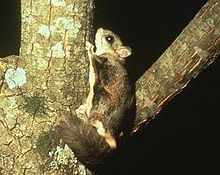Flying squirrel
| Flying squirrel Temporal range: Early Oligocene – Recent
| |
|---|---|

| |
| Northern flying squirrel (Glaucomys sabrinus) | |
| Scientific classification | |
| Domain: | Eukaryota |
| Kingdom: | Animalia |
| Phylum: | Chordata |
| Class: | Mammalia |
| Order: | Rodentia |
| Family: | Sciuridae |
| Subfamily: | Sciurinae |
| Tribe: | Pteromyini Brandt, 1855 |
| Genera | |
|
Aeretes | |

Flying squirrels are a tribe of 44 species in the squirrel family Sciuridae.[2] Despite the name, none use powered flight: all are gliders.
They are sociable, noisy rodents that glide from tree to tree, using a flap of loose skin that connects their front and hind legs. They can glide up to 150 feet (46 m), steering with their tail, and landing on tree trunks, gripping it with all four feet.
These squirrels are nocturnal (most active at night). They have a life span of about five years in the wild, and about 13 years in captivity. Flying squirrels live in forests in North America, Europe and Asia.
Flying squirrels eat mostly plants, like seeds, nuts, leaves, maple sap, bulbs, bark, flowers, and roots. Less often, they eat insects, eggs, worms, small birds, and other small animals.
Flying squirrels are hunted by weasels, foxes, hawks, and coyotes.
Evolution[change | change source]
Before the 21st century, the evolutionary history of the flying squirrel was often debated.[3] This debate was clarified by two recent molecular studies.[4][5] These studies found that the living flying squirrels originated 18–20 million years ago, are monophyletic, and have a sister relationship with tree squirrels.
There are reasons which may explain why gliding has evolved in mammals: [6]
- economical locomotion: moving between trees using as little energy as possible.
- finding food: economical searching.
- avoiding predators.
- reducing landing forces as compared to simple jumping.
References[change | change source]
- ↑ Daxner-Höck G. (2004). "Flying Squirrels (Pteromyinae, Mammalia) from the Upper Miocene of Austria". Annalen des Naturhistorischen Museums in Wien 106A: 387–423. PDF.
- ↑ Thorington R.W. Jr. and R.S. Hoffman 2005. Family Sciuridae, pp. 754–818 in Mammal species of the world a taxonomic and geographic reference. D.E. Wilson and D.M. Reeder eds. Johns Hopkins University Press, Baltimore.
- ↑ Arbogast B.S. (2007). "A brief history of the new world flying squirrels: phylogeny, biogeography, and conservation genetics". Journal of Mammalogy. 88 (4): 840–849. doi:10.1644/06-MAMM-S-322R1.1. S2CID 49371808.
- ↑ Mercer J.M. & V.L. Roth (2003). "The effects of cenozoic global change on squirrel phylogeny". Science. 299 (5612): 1568–1572. Bibcode:2003Sci...299.1568M. doi:10.1126/science.1079705. PMID 12595609. S2CID 40366357.
- ↑ Steppan S.J; B.L. Storz & R.S. Hoffmann (2004). "Nuclear DNA phylogeny of the squirrels (Mammalia: Rodentia) and the evolution of arboreality from c-myc and RAG1". Molecular Phylogenetics and Evolution. 30 (3): 703–719. doi:10.1016/S1055-7903(03)00204-5. PMID 15012949.
{{cite journal}}: CS1 maint: multiple names: authors list (link) - ↑ Flaherty E.A; M. Ben-David, W.P. Smith (2010). "Quadrupedal locomotor performance in two species of arboreal squirrels: predicting energy savings of gliding". Journal of Comparative Physiology B-Biochemical Systemic and Environmental Physiology. 180 (7): 1067–1078. doi:10.1007/s00360-010-0470-1. PMID 20361193. S2CID 240833.
{{cite journal}}: CS1 maint: multiple names: authors list (link)
